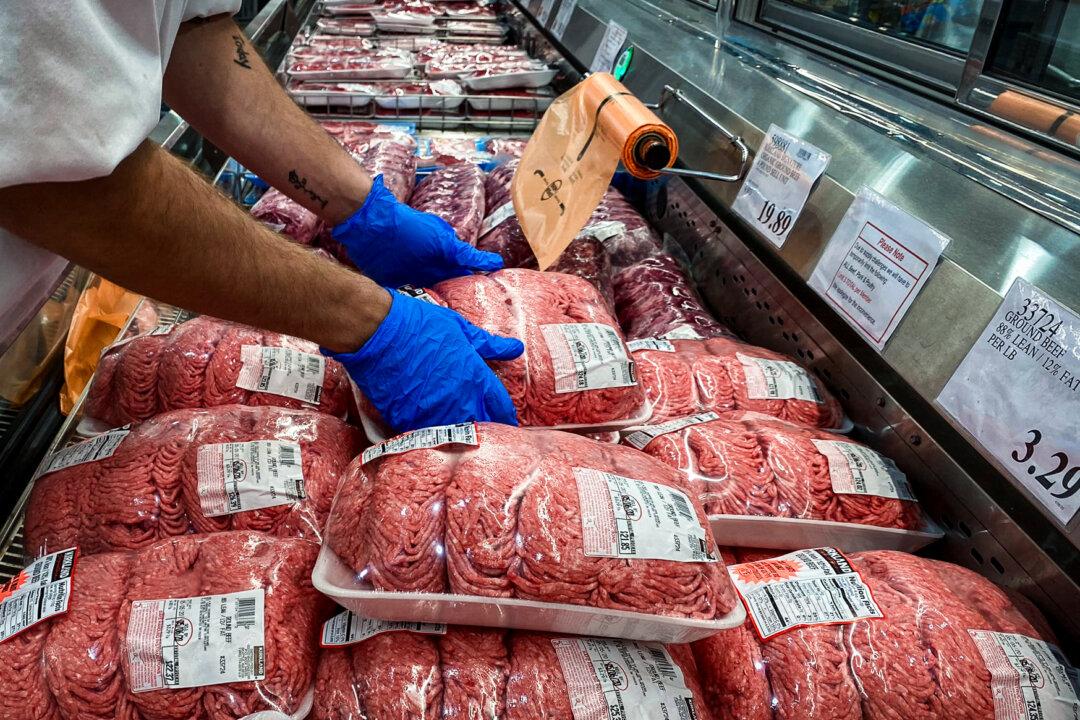Federal food safety inspectors have begun testing ground beef from grocery stores for the presence of bird flu in states where dairy cows have tested positive for the virus, according to the U.S. Department of Agriculture (USDA).
A USDA spokesperson told The Epoch Times in an emailed statement that the agency’s Food Safety and Inspection Service (FSIS) is carrying out three separate beef safety studies, including one that involves sampling ground beef from grocery stores in the nine states where dairy cattle have tested positive for the H5N1 bird flu.
“Samples are being collected at retail outlets in the states in which dairy cow herds have tested positive for H5N1 influenza virus,” the spokesperson said, adding that the ground beef samples will be analyzed using polymerase chain reaction (PCR), which can detect whether any viral particles are present.
The second study involves testing beef muscle from dairy cows that were condemned at selected slaughterhouses for the presence of bird flu.
“For the second sampling effort, FSIS is currently collecting muscle samples at FSIS-inspected slaughter facilities of cull dairy cattle that have been condemned for systemic pathologies,” the spokesperson clarified.
The third study is a ground beef cooking study, which involves using a “virus surrogate” in ground beef and cooking it at different temperatures to “determine log-reduction” of the H5N1 virus, the spokesperson said.
So far, no beef cattle have tested positive for the H5N1 virus. Last week, the USDA said it found bird flu in a lung tissue sample from an asymptomatic dairy cow that was sent to slaughter from an infected herd. The agency said that the animal did not enter the food supply.
The USDA spokesperson told The Epoch Times that the results of the three beef safety studies are forthcoming and would be released to the public. He added that the USDA has a “rigorous” meat inspection process and the agency “is confident that the meat supply is safe.”
“While we have multiple safeguards in place to protect consumers, we recommend consumers properly handle raw meats and cook to a safe internal temperature,” the spokesperson said. “Cooking to a safe internal temperature kills bacteria and viruses in meat.”
Dairy Cow Testing
The USDA and the Animal and Plant Health Inspection Service (APHIS) have begun requiring lactating dairy cows to test negative for bird flu before being moved across state lines in a bid to stem the spread of the virus.Owners of herds containing cows that test positive are encouraged to work with local and state health agencies, including by allowing public health officials to access on-farm activities.
Farm workers who are exposed to bird flu-infected cattle should be monitored daily for signs and symptoms of acute respiratory illness.
“While it is still unclear exactly how virus is spreading, the virus is shed in milk at high concentrations; therefore, anything that comes in contact with unpasteurized raw milk, spilled milk, etc. may spread the virus including other animals, vehicles, and other objects or materials,” the USDA cautioned in the guidance document. “Therefore, both dairy and poultry producers should redouble biosecurity efforts and be vigilant about monitoring for and controlling disease in their herds and flocks.”
To date, Colombia is the only country that has restricted the import of beef and beef products coming from U.S. states where dairy cows have tested positive for bird flu.
“The patient reported conjunctivitis with no other symptoms, was not hospitalized, and is recovering,” the CDC said. “The patient was recommended to isolate and received antiviral treatment with oseltamivir.”
The Texas farm worker is only the second case ever of the H5N1 virus to be detected in humans.







